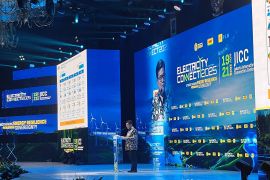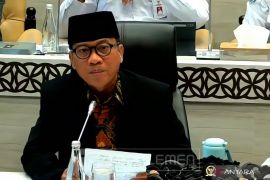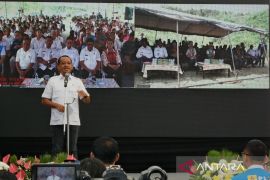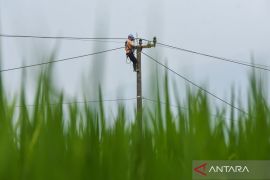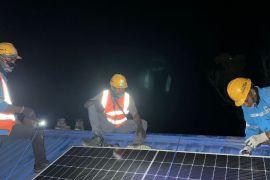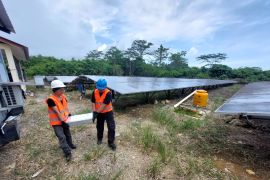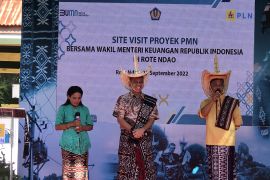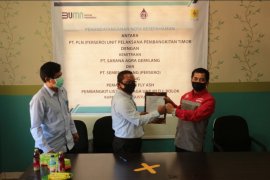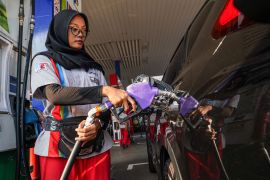Nowadays, electricity has become a primary need for society. Almost all activities, from education and healthcare to economic activities, depend on a reliable supply of electricity.
Therefore, ensuring equitable access to electricity by meeting the electrification ratio is one of the government's priorities in realizing inclusive and sustainable development.
Behind the bright lights of large cities, disadvantaged, frontier, and outermost (3T) regions are still lacking electrification.
The national electrification ratio on the first half of 2025 was recorded at 99.83 percent, showing that 0.17 percent of regions in Indonesia have not yet fully benefited from access to electricity.
To address this challenge, the government is accelerating the development of New and Renewable Energy (NRE)-based electricity infrastructure for equal power distribution of electricity throughout the country.
The utilization of renewable energy is carried out not only by maximizing the electrification potential of 3,700 gigawatts (GW) from wind, solar, biomass, and geothermal energy, but also at boosting the renewable energy mix to 23 percent by 2030.
Related news: Illuminating the future with geothermal power
Freedom from Darkness
One of the strategic initiatives designed to achieve full electrification is the Merdeka dari Kegelapan (Freedom from Darkness) program.
Implemented in collaboration with the State Electricity Company (PLN), the program encompasses three major activities.
First, the New Electricity Installation Assistance Program (BPBL) in Minahasa, North Sulawesi; second, the inauguration of the 128-kilowatt (kW) Wairara Micro-Hydro Power Plant (PLTMH) in East Sumba, East Nusa Tenggara (NTT); and third, the inauguration of the Anggi Micro-Hydro Power Plant Phase I with a capacity of 150 kW, and the groundbreaking for the Anggi Micro-Hydro Power Plant Phase II with a capacity of 250 kW in the Arfak Mountains, West Papua.
North Sulawesi, NTT, and West Papua were chosen as program targets, as many villages in these regions remain without electricity.
In North Sulawesi, the Ministry of Energy and Mineral Resources (ESDM) reported that the province’s electrification ratio has reached 99.40 percent, while West Papua and NTT recorded ratios of 89.80 percent.
In North Sulawesi, electrification is being increased through the Tonsea Lama Hydroelectric Power Plant (PLTA).
This environmentally friendly facility, with a capacity of 12 megawatts (MW), supplies electricity to 204 sub-districts in North Sulawesi and Gorontalo, or approximately 6,120 households.
In the same region, the government is participating in the BPBL program to connect electricity to one thousand households, targeting 2,700 households this year.
Each BPBL package includes a home electrical installation with three light points and one outlet, a certificate of operational worthiness (SLO), a 900 VA PLN grid connection, and an initial electricity token worth Rp100,000 (US$5.84).
As of September 2025, a total of 135,482 households nationwide had been connected to electricity, out of a target of 215,000 households for the year.
In East Nusa Tenggara (NTT), renewable energy electrification efforts are being realized through the construction of the Wairara Micro-Hydro Power Plant (MHP).
Since beginning operations in November 2022, this plant has supplied electricity to 105 customers, including community health centers, schools, churches, and local government offices.
With a newly installed capacity of 128 kW, the facility is expected to power thousands of homes in the surrounding area.
Meanwhile, in the Arfak Mountains of West Papua, electrification through renewable energy is being accelerated with two simultaneous projects: the 150 kW Anggi Micro-Hydro Power Plant Phase I and the 250 kW Phase II.
These projects are expected to significantly increase the region’s electrification ratio, which currently stands at 89.80 percent.
Related news: Full electrification targeted by 2030, focusing on remote areas: Govt
Multiplier Effect
The use of renewable energy for power generation not only provides environmental benefits but also brings strong economic impacts.
The presence of micro-hydro power plants (MHP) in two remote areas of Anggi, West Papua, and Wairara, East Sumba, East Nusa Tenggara, has created a significant economic multiplier effect.
Affordable and sustainable electricity not only reduces community energy costs by more than 80 percent but also fuels the productivity chain from households, micro-enterprises, and public services.
Through the combined operation of the 150 kW Anggi Phase I and 2 × 250 kW Anggi Phase II MHPs, the government has reduced dependence on fossil fuel-based diesel, which is costly and emits high levels of carbon.
According to PLN’s calculations, the renewable energy electrification project in West Papua has saved up to Rp6.7 billion (US$391 thousand) annually in diesel fuel costs.
Over the past two and a half years, total energy cost savings have reached around Rp17 billion (US$992 thousand), helping meet the region’s electricity needs.
In NTT, the renewable energy electrification project under the Merdeka dari Kegelapan program has also generated notable multiplier effects. Before the installation of the micro-hydro power plant, residents relied entirely on diesel generators, consuming 0.4 liters of fuel per kWh at a cost of Rp2,720 (US$0.16) per kWh.
Now, electricity costs have dropped to Rp1,600 (US$0.09) per kWh, saving residents nearly 50 percent in expenses and reducing diesel use by up to 62,000 liters per year, or about Rp1.24 billion (US$72 thousand).
Renewable energy not only powers turbines to light up homes in 3T regions but also stimulates local economies, supports education, and strengthens community confidence that access to electricity is not exclusive to urban areas.
When electricity comes from nature, prosperity grows from the land itself.
Related news: Indonesia expands rural energy access with community programs
Editor: M Razi Rahman
Copyright © ANTARA 2025

